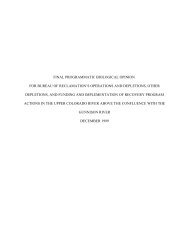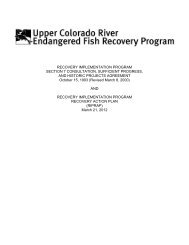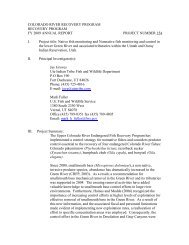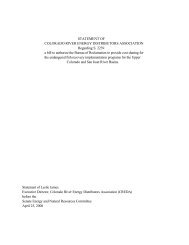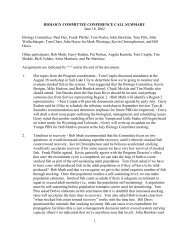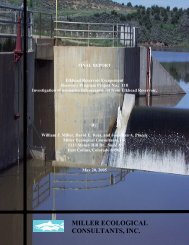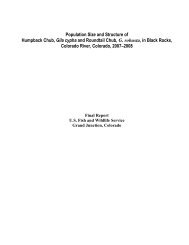K. R. Bestgen, K. A. Zelasko, and G. C. White. Monitoring ...
K. R. Bestgen, K. A. Zelasko, and G. C. White. Monitoring ...
K. R. Bestgen, K. A. Zelasko, and G. C. White. Monitoring ...
You also want an ePaper? Increase the reach of your titles
YUMPU automatically turns print PDFs into web optimized ePapers that Google loves.
Low precision of survival rate estimates reflected the low probabilities of capture of fish<br />
in each reach, but particularly for the middle Green River, where capture rates ranged from<br />
0.004–0.02 over the three-year period (Table 7). Capture rates for the lower Green River were<br />
slightly higher <strong>and</strong> more fish existed in that reach, so p’s were slightly higher at 0.01–0.07 over<br />
the 2006–2008 period. Those rates consisted of the following across-year captures: 2 fish<br />
captured in 2006 <strong>and</strong> 2007, 9 fish captured in 2006 <strong>and</strong> 2008, 11 fish captured in 2007 <strong>and</strong> 2008,<br />
<strong>and</strong> 1 fish captured in all three years. Capture rates exist for the Desolation-Gray Canyon reach<br />
only because within year recaptures were observed; those ranged from 0.008–0.04 <strong>and</strong> were<br />
slightly higher than those in the middle Green River but lower than those in the lower Green<br />
River. In the middle Green River, only five razorback suckers were recaptured across years: 3<br />
from 2006 to 2007 <strong>and</strong> 2 from 2007 to 2008. Overall, capture rates for all reaches were highest<br />
in 2006 (0.02–0.07), very low in 2007 (0.008–0.01), <strong>and</strong> intermediate in 2008 (0.01–0.04).<br />
Capture rates for Colorado pikeminnow in the same reaches <strong>and</strong> years were also highest in 2006,<br />
but tended to be higher in 2007 than 2008 (<strong>Bestgen</strong> et al. 2010). River flow rates were low in<br />
2007, which may have made sampling more difficult, <strong>and</strong> in at least one reach, effort (in terms of<br />
days of sampling) was relatively low.<br />
Abundance estimates of razorback suckers varied dramatically across years in each reach<br />
(Table 8, abundance estimates). Abundance was highest in the lower Green River, ranging from<br />
nearly 1600 fish in 2006 to 5153 in 2007, <strong>and</strong> then declining to 2597 in 2008. Razorback sucker<br />
abundance was lowest in the Desolation-Gray Canyon reach of the Green River, ranging from<br />
nearly 474 fish in 2006 to 3011 in 2007, <strong>and</strong> then declining to 836 in 2008. Abundance was<br />
intermediate in the middle Green River reach, ranging from nearly 600 fish in 2006 to 3146 in<br />
2007, <strong>and</strong> then declining to about 1200 in 2008.<br />
Razorback sucker abundance estimates were relatively imprecise in all reaches <strong>and</strong> years.<br />
Abundance estimates for Green River razorback suckers in the period 2006–2008 were the most<br />
precise in the lower Green River, with CV’s of 22–37% among years, <strong>and</strong> reflected the relatively<br />
higher capture rates in that reach. The confidence limits for abundance estimates in other<br />
reaches were very wide <strong>and</strong> the CV’s ranged from 49 to 81%, which limits any meaningful<br />
inference to those estimates. However, relatively precise estimates of large-river fish abundance<br />
are possible. For example, estimates of Colorado pikeminnow in the middle Green River reach<br />
from 2000–2003 had CV’s of 9–18% (<strong>Bestgen</strong> et al. 2007). The higher recapture probabilities<br />
34



